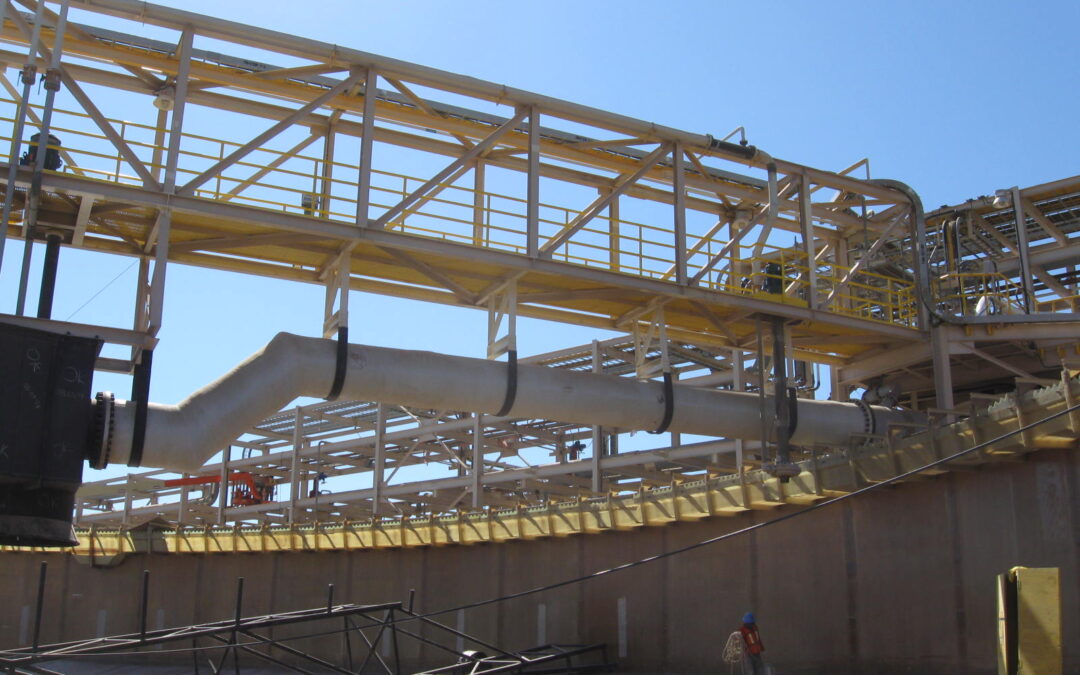Although a relative newcomer to the mineral/metal processing industry, fiberglass reinforced plastic (FRP) has been a material of construction for piping and process equipment for more than 50 years.
Some of the first installations of FRP piping were for handling petroleum effluents and byproducts. Once the material became more recognized, it began to be used for the construction of storage tanks, piping and gas ducts in the pulp and paper industry. Early resin systems were typically epoxies and polyesters. Today’s composite technology offers a range of advanced resin systems including vinyl esters and epoxy novolac vinyl esters, for a host of chemical-resistant applications.
FRP also has a history of over 40 years in seawater applications, such as in power utility seawater cooling piping and desalination piping systems. It has proven to be a reliable and cost effective material in many acid environments such as sulphuric, hydrochloric and phosphoric acids for a variety of process applications, and in gas scrubbing applications, FRP and dual laminates have been effective materials of construction for handling gas services containing mineral salts and weak acids in the flow stream.
FRP laminates are versatile and can be readily enhanced to develop abrasion-resistant and conductive qualities. While maintaining its chemical resistance, abrasion resistant qualities are developed in FRP laminates by adding solids such as a silicon carbide, alumina oxide or ceramics to the resin mixture for construction of the corrosion barrier inner lining.
Where combustible organics, such as kerosene, are in a dissolved effluent, FRP can be made conductive by introducing a carbon veil and/or carbon graphite powder into the first stage of the corrosion barrier construction. With this conductive corrosion barrier any static charge can be dissipated to a grounding connection and safely to ground. Conductive veils have proven to be a reliable means to assist in managing these risks associated with combustible and corrosive services.
In lixiviation, FRP is used throughout the solvent extraction process. FRP tanks handle the storage of acids, process effluents and mineral salts, and in many applications, can be expected to provide low maintenance service for over 20 years, assuming proper design, fabrication and operation.
System design
FRP manufacturing technology has significantly advanced the construction and quality of large diameter field fabricated FRP tanks. Today these are being built in sizes over 30m in diameter, and FRP piping for process fluid transfer are regularly designed for applications over 1.5m in diameter.
In high volume desalination services, FRP piping has been built up to 4m in diameter. After 40+ years of service, FRP seawater systems have been internally inspected and found to in serviceable condition with little to no maintenance required.
Piping system reliability should be independent of the material of construction. If proper material choices are made for a given application, the expectations of system performance should be high with few maintenance concerns.
Thermal expansion is a notable consideration in system design. Depending on the type of laminate construction and design temperatures of the piping system, FRP will expand 2.5 to 3 times the comparative rate of carbon steel.
At typical process temperatures ranging from 60-95oC, thermal expansion can be a governing factor in the system design. Depending on the geographic location of the plant, occasional loads such as wind and seismic can be significant factors as well. In these applications, it is frequently necessary to evaluate FRP piping systems using a formal pipe stress/flexibility program to conduct a comprehensive engineering evaluation to validate the system performance within the defined limits of the governing code.
A comprehensive evaluation should include project- or vendor-specific material properties and realistic estimates of stiffness for equipment connections, supports and supporting steel, as these are rarely truly rigid.
Unreasonable estimates of support stiffness and boundary conditions can result in unjustified and excessive piping loads on equipment and excessive predictions of system stresses. Qualified estimates of input data will yield the most reliable and defendable results for system engineering.
Fabrication
To achieve quality expectations during fabrication and installation of FRP equipment, the project must rely on well-defined standards, detailed and descriptive specifications and the best industry practices defined within those documents.
Time will be well-spent to develop a clear and concise equipment specification. This time will be appreciated in the heat of the project when questions are raised, which are critical to the quality and performance of the equipment.
During the fabrication and installation of piping and large equipment, such as process vessels, stacks and linings, joints are made by laminate bonding. Whether in the shop or in the field, a reasonable measure of environmental controls- managing temperature, humidity and cleanliness- is required to achieve consistent results. A clean and dry work environment is required to produce satisfactory laminates.
FRP piping and field fabricated tanks are installed all over the world, and in the range of climatic conditions. A desirable working temperature for most resin systems lies between about 10 and 45oC. Where ambient conditions are more extreme, measures should be taken to control and improve the work environment, such as tarping for shade or rain protection and tenting, where a portable temporary enclosure is needed to further condition the immediate work space. These are typical jobsite measures to manage the elements during an FRP installation.
Conclusion
From a cost and delivery standpoint, FRP can be an attractive material choice for hydrometallurgy. As with most projects, the key to success is managing resources and taking care of the details.
FRP is a mainstream material of construction for an abundance of corrosive applications. The continued development of best practices and quality standards will only build greater confidence in FRP for these applications.


Recent Comments